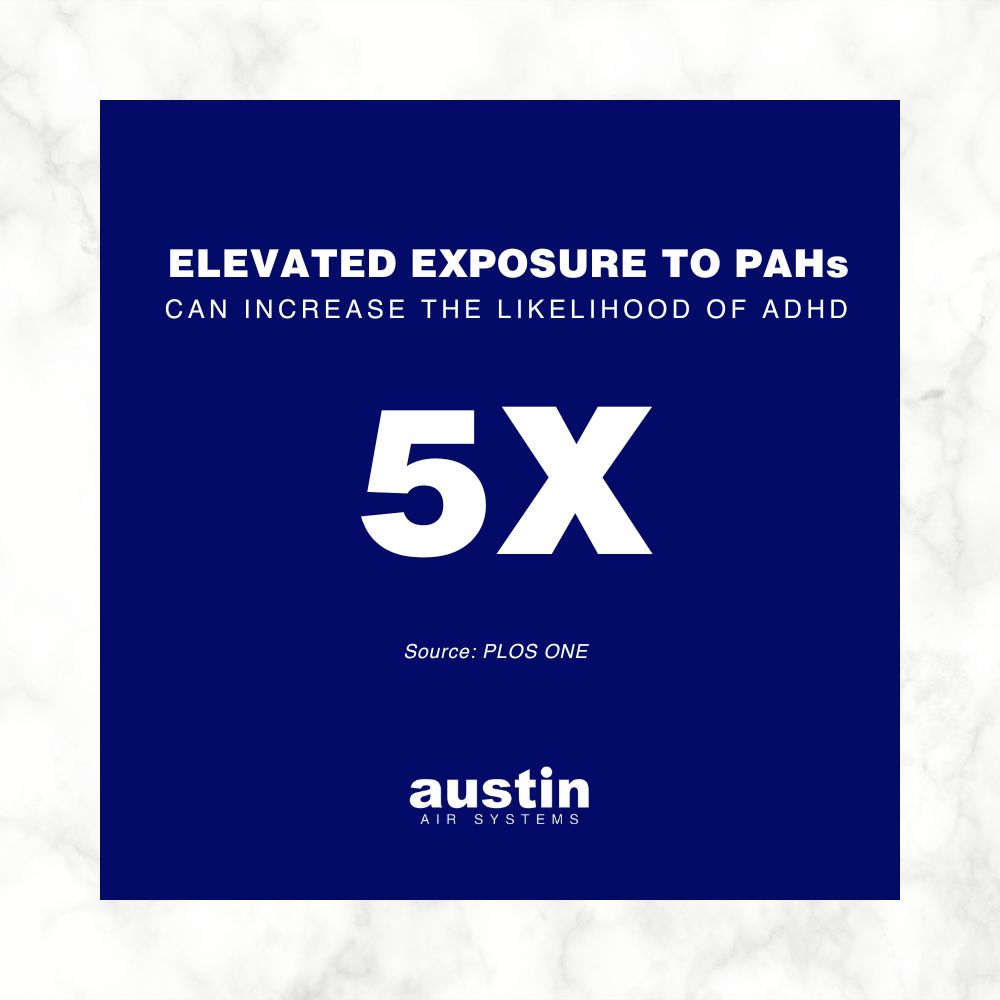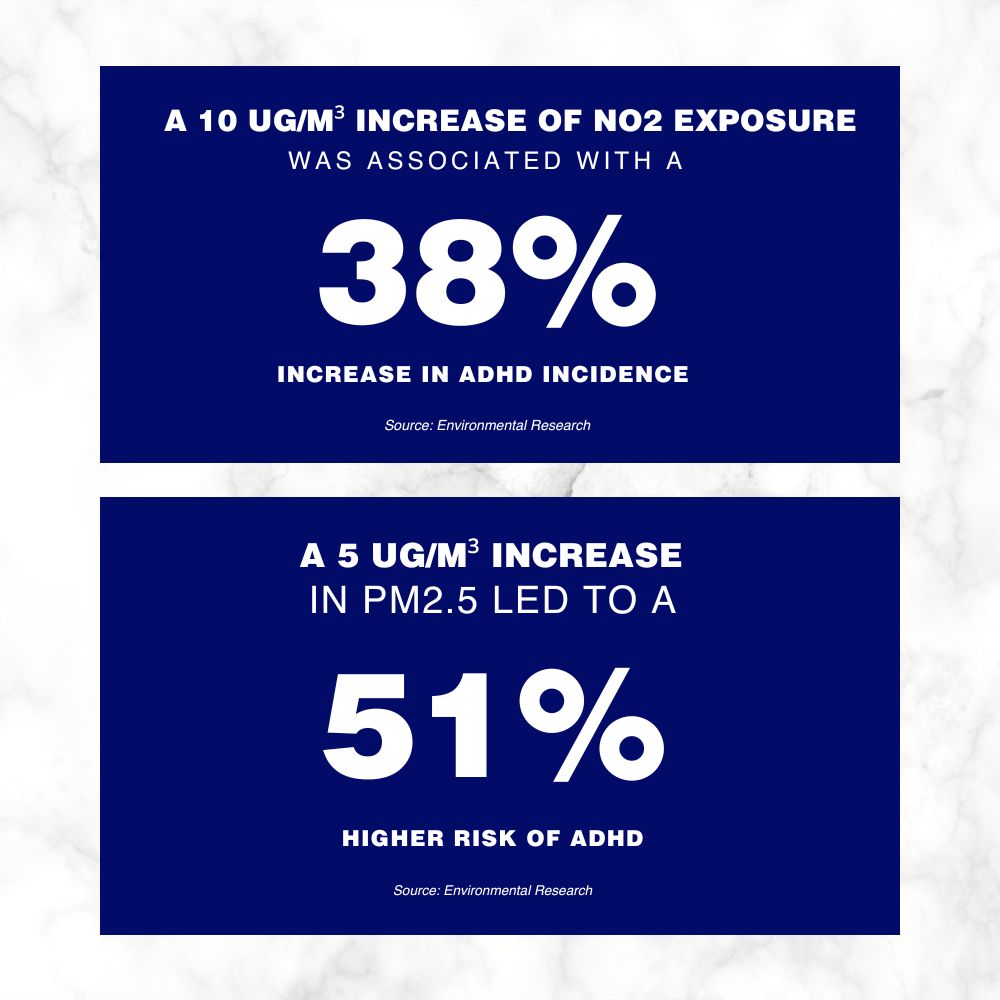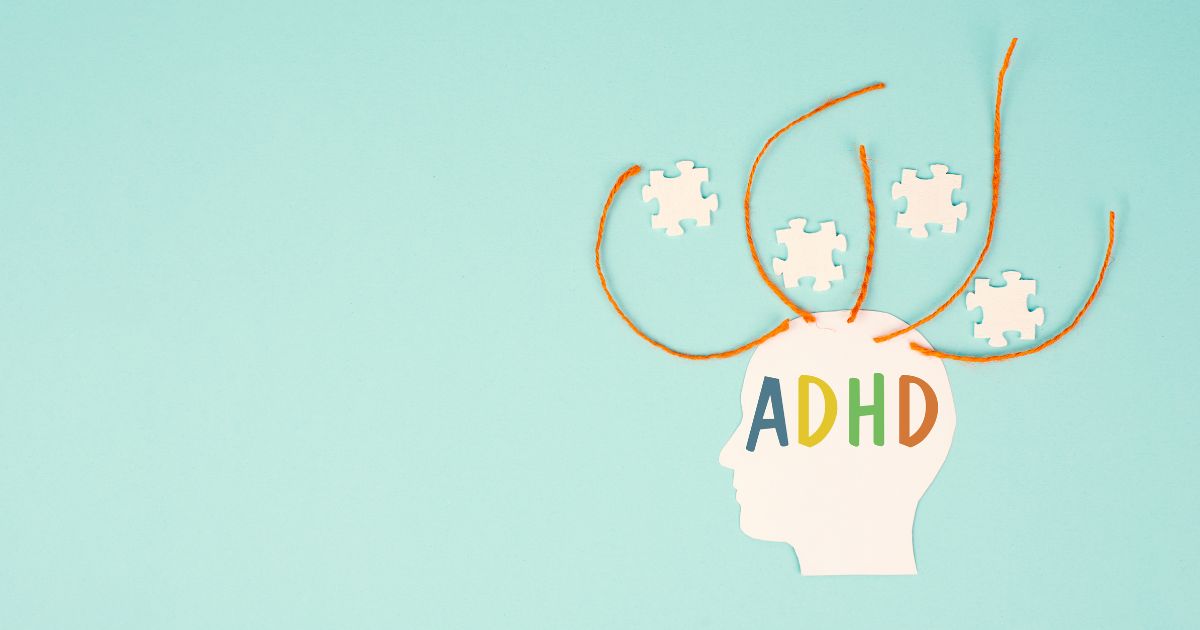October is Attention-Deficit/Hyperactivity Disorder (ADHD) Awareness Month. ADHD is a complex neurodevelopmental disorder that affects millions of children and adults worldwide – approximately 8.4% of children as well as 2.5% of adults.1 While genetics play a major role, there is a mountain of research highlighting the significant impact of air pollution on the development of ADHD, as well as the worsening of symptoms.
In observance of ADHD Awareness Month this October, we’ll share some of the science linking air pollution exposure and ADHD. We’ll also discuss some basic ways that you can provide support for those in your life who have ADHD.
PAHs and ADHD: Prenatal Exposure Increases Risk
A study conducted in New York City found a strong association between prenatal exposure to polycyclic aromatic hydrocarbons (PAHs) and the development of ADHD by age 9.2 PAHs are neurotoxic pollutants commonly produced by the combustion of fossil fuels and materials like wood and coal, making PAHs especially prevalent in highly populated and industrial urban areas.3
This prompted researchers to follow a cohort of children born to nonsmoking women who live in New York City from the womb until age 9. They measured the level of PAH-DNA adducts, which indicate exposure to PAHs, in both maternal and cord blood. The findings revealed that high prenatal PAH exposure significantly increased the likelihood of ADHD-related symptoms.
Specifically, children whose mothers had elevated levels of PAH adducts were more than five times as likely to show ADHD symptoms.
While this study focused on prenatal exposure, it adds to a growing body of evidence that air pollution during critical developmental periods can have lasting effects on a child’s cognitive and behavioral health, like the study from Denmark below.

Nitrogen Dioxide and Particulate Matter: Early Childhood Exposure
A large study conducted in Denmark examined the effects of early-life exposure to nitrogen dioxide (NO2) and fine particulate matter (PM2.5) on the development of ADHD.4 The cohort followed over 800,000 children born between 1992 and 2007, using air-modeling data to estimate pollutant exposure levels during the first five years of life.
Researchers found a significant increase in ADHD risk with higher exposure to NO2 and PM2.5. An increase of 10 micrograms per cubic meter (μg/m³) in NO2 was associated with a 38% increase in ADHD incidence, while a 5 μg/m³ increase in PM2.5 led to a 51% higher risk.
Interestingly, when both pollutants were considered simultaneously, the risk associated with NO2 remained strong, while the link with PM2.5 diminished, suggesting that NO2 may be a more direct contributor to ADHD development, likely due to its role in traffic-related pollution.
This research underscores the critical role air pollution, particularly traffic-related pollutants like NO2, plays in shaping neurodevelopment during early childhood. This is especially of concern for daycares and early childhood education centers which are located in areas that have heavy traffic.

PM Exposure in Taiwan: A Growing Concern
A study conducted in Taiwan also explored the association between early-life exposure to particulate matter (PM10 and PM2.5) and ADHD.5 Their analysis confirmed that higher concentrations of these particles in the air significantly increased the risk of ADHD, even after adjusting for factors such as age, sex, urbanization level, and other health complications.
This study is consistent with findings from other regions, including Mexico, Spain, and India, where PM exposure has been linked to cognitive impairments and behavioral issues. This study further proves that PM exposure induces oxidative stress and neuroinflammation, which can damage dopaminergic cells in the brain – cells responsible for attention and impulse control. Dopamine, a key neurotransmitter, is crucial for these brain functions, so any damage to these cells could increase the risk of ADHD.
While this research further solidifies the connection between air pollution and ADHD, there are still gaps in understanding of the precise doses. More controlled studies are needed to better define the mechanisms through which PM exposure influences ADHD development but the link is undeniable.
Short-Term Pollution Exposure and ADHD Symptoms in Adolescents
In addition to long-term exposure, short-term pollution spikes can also worsen ADHD symptoms, particularly in adolescents. A study from South Korea found that short-term exposure to PM10, nitrogen dioxide (NO2), and sulfur dioxide (SO2) was associated with increased ADHD-related hospital admissions in adolescents aged 10–19.6
The risk of hospitalization was highest for NO2 and SO2, with older adolescents (aged 15–19) being more vulnerable to the effects of these pollutants. This study highlights that even short-term fluctuations in air quality can significantly impact individuals already living with ADHD, intensifying symptoms such as hyperactivity, inattentiveness, and impulsivity, and leading to the need for acute care.
The Need for Cleaner Air
The evidence linking air pollution to ADHD development and symptom worsening continues to grow. From prenatal exposure to PAHs to early-life exposure to NO2 and PM, pollutants are emerging as significant environmental risk factors for ADHD. While reducing personal exposure to air pollution – such as through the use of HEPA and activated carbon Austin Air Purifiers – can help, broader measures are essential.
With ADHD rates rising and air pollution continuing to affect millions, clean air is more important than ever for healthy neurodevelopment. That’s why schools everywhere are choosing medical grade Austin Air purifiers for classrooms. It’s also why Austin Air has created the free Parent Teacher Toolkit which teaches adults how to get cleaner air in schools. It even provides guidance on how to pursue funding for free classroom air cleaners.
Austin Air has also created a middle and high school assembly program, “See Air Differently,” available online, which teaches students how to breathe cleaner air and discourages unhealthy habits like vaping. This assembly is provided for free to schools that partner with Austin Air. (Contact us for more details.)
How to Help
Besides providing cleaner air with an Austin Air Purifier, you can support people with ADHD in the following ways:
- Educate Yourself
Learn about ADHD from credible sources. Understanding the challenges and strengths associated with ADHD helps reduce stigma and builds empathy. Books, podcasts, and websites like Children and Adults with Attention-Deficit/Hyperactivity Disorder (CHADD) provide valuable information.
- Be Patient and Understanding
People with ADHD often struggle with focus, time management, and impulsivity. Show patience when they experience difficulties, and avoid harsh judgments. Offering gentle reminders or creating an ADHD-friendly environment can help.
- Offer Help with Organization
Many people with ADHD struggle with staying organized. Offer assistance in setting up systems that work for them, whether it’s a calendar, reminders, or organizing their workspace. Tools like apps, visual schedules, or color-coded systems can be useful.
- Respect Individual Needs
Everyone with ADHD is different. Some may need accommodations in the workplace, at school, or in social settings. Respect their individual needs, such as taking breaks or using noise-canceling headphones to manage distractions.
- Practice Active Listening
Many people with ADHD feel misunderstood or dismissed. Take time to actively listen to their experiences and feelings without interrupting or minimizing their challenges. This can provide emotional support and foster a deeper connection.
- Avoid Stereotypes
Avoid common myths and stereotypes, like the idea that ADHD is “just about being hyper” or that it’s not a real condition. Speak up against misinformation and help create a more supportive, informed community.
- Celebrate ADHD Strengths
Help shift the narrative by celebrating the strengths of ADHD, such as creativity, hyperfocus on areas of interest, and out-of-the-box thinking. Acknowledging these traits can help people with ADHD feel valued and appreciated.
These actions help raise awareness, reduce stigma, and create a more supportive environment for people with ADHD, not just in October but year-round.

REFERENCES
1 What is ADHD? (June 2022). American Psychiatric Association. https://www.psychiatry.org/patients-families/adhd/what-is-adhd.
2 Perera FP, Chang H, Tang D, et al. (2014 November 5). Early-Life Exposure to Polycyclic Aromatic Hydrocarbons and ADHD Behavior Problems. PLoS ONE. 9(11), e111670. doi:10.1371/journal.pone.0111670.
3 Polycyclic Aromatic Hydrocarbons (PAHs). (2023 May 25). CDC Agency for Toxic Substances and Disease Registry. https://www.atsdr.cdc.gov/csem/polycyclic-aromatic-hydrocarbons/what_are_pahs.html.
4 Thygesen M, Holst GJ, Hansen B, et al. (2019 November 22). Exposure to air pollution in early childhood and the association with Attention-Deficit Hyperactivity Disorder. Envi Res. 183, 108930. doi: 10.1016/j.envres.2019.108930.
5 Fan HC, Chen CM, Tsai JD, et al. (2022 December 2) Association between Exposure to Particulate Matter Air Pollution during Early Childhood and Risk of Attention-Deficit/Hyperactivity Disorder in Taiwan. Int J Environ Res Public Health. 19(23): 16138. doi: 10.3390/ijerph192316138.
6 Park J, Sohn JH, Cho SJ, et al. (November 2020). Association between short-term air pollution exposure and attention-deficit/hyperactivity disorder-related hospital admissions among adolescents: A nationwide time-series study. Envi Pol. 266, 115369. doi: 10.1016/j.envpol.2020.115369.
